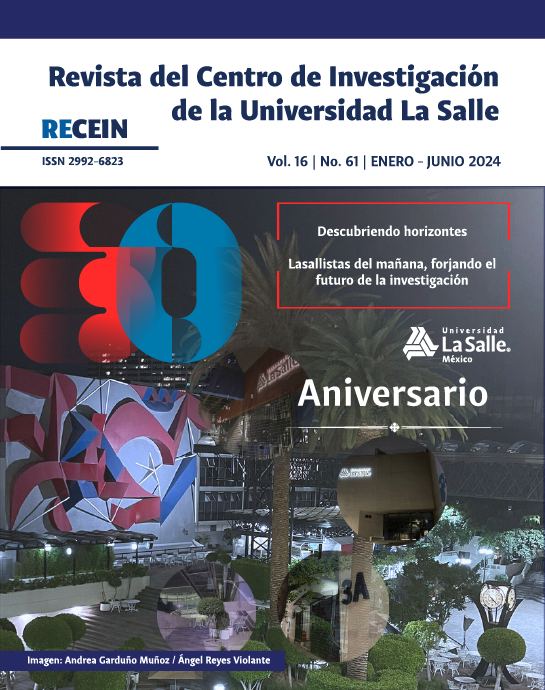Revisión sistemática de la literatura científica relacionada con el modelo de innovación quíntuple hélice y su correlación con la rentabilidad empresarial: un análisis bibliométrico826
Contenido principal del artículo
Resumen
El objetivo de esta investigación es realizar una revisión sistemática de la producción científica relacionada con el modelo de innovación quíntuple hélice. En específico, se busca identificar si existen trabajos previos que establezcan una relación entre dicho modelo de innovación y la rentabilidad empresarial. La metodología se basa en un análisis bibliométrico de la literatura científica en la base de datos académica Dimensions. Los resultados del análisis sugieren que no existen trabajos científicos que relacionen directamente el modelo de innovación quíntuple hélice con la rentabilidad empresarial.
Descargas
Detalles del artículo

Esta obra está bajo una licencia internacional Creative Commons Atribución-NoComercial-CompartirIgual 4.0.
Esta revista se encuentra bajo la licencia de Creative Commons, por tanto, los autores, al postular su artículo, lo adhieren a dicha licencia.El autor puede disponer de su artículo para su archivo en repositorios institucionales o en páginas web personales, con la referencia y agradecimientos a la fuente donde se ha publicado.
Citas
Abramo, G., D’Angelo, C. A., & Mele, I. (2022). Impact of Covid-19 on research output by gender across countries. Scientometrics, 127(12), 6811–6826. https://doi.org/10.1007/s11192-021-04245-x
Atanassova, I., Bertin, M., & Mayr, P. (2019). Editorial: Mining Scientific Papers: NLP-enhanced Bibliometrics. Frontiers in Research Metrics and Analytics, 4, 462725. https://doi.org/10.3389/FRMA.2019.00002
Belter, C. W. (2015). Bibliometric indicators: opportunities and limits. Journal of the Medical Library Association : JMLA, 103(4), 219. https://doi.org/10.3163/1536-5050.103.4.014
Bikse, V., & Rivza, B. (2017). The Helix Model System as a Challenge and Driver for Rural and Regional Development. New Trends and Issues Proceedings on Humanities and Social Sciences, 2(6), 24–34. https://doi.org/10.18844/PROSOC.V2I6.1425
Braunerhjelm, P., & Svensson, R. (2010). The inventor’s role: Was Schumpeter right? Journal of Evolutionary Economics, 20(3), 413–444. https://doi.org/10.1007/s00191-009-0157-5
Cai, Y., & Amaral, M. (2022). Triple Helix Model of Innovation: From Boundaries to Frontiers. Triple Helix, 9(2), 107–117. https://doi.org/10.1163/21971927-12340007
Caputo, F., Cano, J. A., Londoño-Pineda, A., Castro, M. F., Bécquer Paz, H., Rodas, C., & Arias, T. (2022). A Bibliometric Analysis and Systematic Review on E-Marketplaces, Open Innovation, and Sustainability. Sustainability 14(9), 5456. https://doi.org/10.3390/su14095456
Carayannis, E., Barth, T. D., & Campbell, D. F. (2012). The Quintuple Helix innovation model: global warming as a challenge and driver for innovation. Journal of Innovation and Entrepreneurship, 1(1), 2. https://doi.org/10.1186/2192-5372-1-2
Carayannis, E., & Campbell, D. F. J. (2009). Mode 3 and “Quadruple Helix”: Toward a 21st century fractal innovation ecosystem. International Journal of Technology Management, 46(3–4), 201–234. https://doi.org/10.1504/ijtm.2009.023374
Carayannis, E. G., Barth, T. D., Campbell, D. F. J., Carayannis, E. G., Barth, T. D. ;, & Campbell, D. F. J. (2022). O Modelo de Inovação da Hélice Quíntupla. In Revista Direito, Inovação e Regulações, 1(2), 89-111. https://periodicos.univel.br/ojs/index.php/redir/article/view/178
Carayannis, E. G., & Campbell, D. F. J. (2010). Triple helix, Quadruple helix and Quintuple helix and how do Knowledge, Innovation and the Environment relate to Each other? a proposed framework for a trans-disciplinary analysis of sustainable development and social ecology. International Journal of Social Ecology and Sustainable Development, 1(1), 41–69. https://doi.org/10.4018/JSESD.2010010105
Carayannis, E. G., & Campbell, D. F. J. (2021). Democracy of Climate and Climate for Democracy: the Evolution of Quadruple and Quintuple Helix Innovation Systems. Journal of the Knowledge Economy, 12(4), 2050–2082. https://doi.org/10.1007/S13132-021-00778-X
Carayannis, E. G., Campbell, D. F. J., & Grigoroudis, E. (2022). Helix Trilogy: the Triple, Quadruple, and Quintuple Innovation Helices from a Theory, Policy, and Practice Set of Perspectives. Journal of the Knowledge Economy, 13(3), 2272–2301. https://doi.org/10.1007/s13132-021-00813-x
Chung, C. J., & Park, H. W. (2014). Mapping Triple Helix innovation in developing and transitional economies: Webometrics, scientometrics, and informetrics. Scientometrics, 99(1), 1–4. https://doi.org/10.1007/S11192-013-1105-6
Etzkowitz, H., & Leydesdorff, L. (1995). The Triple Helix -- University-Industry-Government Relations: A Laboratory for Knowledge Based Economic Development. EASST Review, 14(1), 14–19. https://ssrn.com/abstract=2480085
Fransman, J., Hall, B., Hayman, R., Narayanan, P., Newman, K., & Tandon, R. (2021). Beyond partnerships: embracing complexity to understand and improve research collaboration for global development. Canadian Journal of Development Studies, 42(3), 326–346. https://doi.org/10.1080/02255189.2021.1872507
Galvao, A., Mascarenhas, C., Marques, C., Ferreira, J., & Ratten, V. (2019). Triple helix and its evolution: a systematic literature review. Journal of Science and Technology Policy Management, 10(3), 812–833. https://doi.org/10.1108/JSTPM-10-2018-0103
Giraldo, M. C. B., Toro, O. N. P., Arias, A. V., Arias, M. L. B., & Piedrahita, L. B. (2022). Research trends of the knowledge-based economy: A bibliometric study. Intangible Capital, 18(2), 290–313. https://doi.org/10.3926/IC.2048
Iqbal, A., Ramachandran, S., Siow, M. L., Subramaniam, T., & Mohammad Afandi, S. H. (2022). Meaningful community participation for effective development of sustainable tourism: Bibliometric analysis towards a quintuple helix model. Journal of Outdoor Recreation and Tourism, 39, 100523. https://doi.org/10.1016/J.JORT.2022.100523
Kitsios, F., Kamariotou, M., Grigoroudis, E., & Valipour, M. (2021). Digital Entrepreneurship Services Evolution: Analysis of Quadruple and Quintuple Helix Innovation Models for Open Data Ecosystems. Sustainability, 13(21), 12183; https://doi.org/10.3390/su132112183
Liu, J., Guo, X., Xu, S., & Zhang, Y. (2023). Quantifying the impact of strong ties in international scientific research collaboration. PLOS ONE, 18(1), e0280521. https://doi.org/10.1371/journal.pone.0280521
López-Rubio, P., Roig-Tierno, N., & Mas-Verdú, F. (2022). Context matters: a global bibliometric review of regional innovation systems. International Journal of Technology, Policy and Management, 22(3), 247–270. https://doi.org/10.1504/IJTPM.2022.125257
Metcalfe, S. (2012). J.A. Schumpeter and the theory of economic evolution (One hundred years beyond the theory of economic development). Papers on Economics and Evolution, (1213). Max Planck Institute of Economics. http://hdl.handle.net/10419/88251
Nkundabanyanga, S. K., Mugumya, E., Nalukenge, I., Muhwezi, M., & Najjemba, G. M. (2020). Firm characteristics, innovation, financial resilience and survival of financial institutions. Journal of Accounting in Emerging Economies, 10(1), 48–73. https://doi.org/10.1108/JAEE-08-2018-0094
Nordberg, K., Mariussen, Å., & Virkkala, S. (2020). Community-driven social innovation and quadruple helix coordination in rural development. Case study on LEADER group Aktion Österbotten. Journal of Rural Studies, 79, 157–168. https://doi.org/10.1016/J.JRURSTUD.2020.08.001
Nordhaus, W. D. (2004). Schumpeterian Profits in the American Economy: Theory and Measurement. NBER Working Paper, April, 1–35.
Provenzano, V., Arnone, M., & Seminara, M. R. (2018). The links between smart specialisation strategy, the quintuple helix model and living labs. En Bisello, A., Vettorato, D., Laconte, P., Costa, S. (eds.). Smart and Sustainable Planning for Cities and Regions (pp. 563–571). Springer. https://doi.org/10.1007/978-3-319-75774-2_38
Provenzano, V., Seminara, M. R., & Arnone, M. (2020). Sustainable Development and Transition Management: A New Approach for European Peripheral Areas. En Bevilacqua, C., Calabrò, F., Della Spina, L. (Eds.). New Metropolitan Perspectives (pp. 37–46). https://doi.org/10.1007/978-3-030-52869-0_4
Putera, P. B., Suryanto, S., Ningrum, S., Widianingsih, I., & Rianto, Y. (2022). Three Decades of Discourse on Science, Technology and Innovation in National Innovation System: A Bibliometric Analysis (1990 – 2020). Cogent Social Sciences, 8(1). https://doi.org/10.1080/23311886.2022.2109854
Shabbir, M. S., & Wisdom, O. (2020). The relationship between corporate social responsibility, environmental investments and financial performance: evidence from manufacturing companies. Environmental Science and Pollution Research, 27(32), 39946–39957. https://doi.org/10.1007/s11356-020-10217-0
Shi, X., Wu, Y., & Fu, D. (2020). Does University-Industry collaboration improve innovation efficiency? Evidence from Chinese Firms⋄. Economic Modelling, 86, 39–53. https://doi.org/10.1016/j.econmod.2019.05.004
Singh, V. K., Singh, P., Karmakar, M., Leta, J., & Mayr, P. (2021). The journal coverage of Web of Science, Scopus and Dimensions: A comparative analysis. Scientometrics, 126(6), 5113–5142. https://doi.org/10.1007/s11192-021-03948-5
Sudiana, K., Sule, E. T., Soemaryani, I., & Yunizar, Y. (2020). The Development and Validation of the Penta Helix Construct. Business: Theory and Practice, 21(1), 136–145. https://doi.org/10.3846/BTP.2020.11231
Sultanova, D., & Bagaveeva, A. (2021). Universities driving cooperation and circular change. E3S Web of Conferences, 274. https://doi.org/10.1051/E3SCONF/202127410020
Sun, X., Zheng, S., & Yang, L. (2022). Mapping the Literature on Ecosystem Coopetition: A Bibliometric Analysis from 1993-2021. IEEE International Conference on Industrial Engineering and Engineering Management, 2022-December, 300–304. https://doi.org/10.1109/IEEM55944.2022.9989942
Sweezy, P. M. (1943). Professor Schumpeter’s Theory of Innovation. The Review of Economics and Statistics, 25(1), 93. https://doi.org/10.2307/1924551
Tambunan, M. R. U. D. (2018). Reconstructing Indonesian Fiscal Policy for Sustainable National Electricity: A Quintuple Helix Perspective. BISNIS & BIROKRASI: Jurnal Ilmu Administrasi Dan Organisasi, 24(3), 119-131.
Taskin, Z., & Al, U. (2019). Natural language processing applications in library and information science. Online Information Review, 43(4), 676–690. https://doi.org/10.1108/OIR-07-2018-0217
Van Eck, N. J., & Waltman, L. (2014). Visualizing Bibliometric Networks. In Measuring Scholarly Impact (pp. 285–320). Springer International Publishing. https://doi.org/10.1007/978-3-319-10377-8_13
Dimensions (2023). Why did we build Dimensions? https://www.dimensions.ai/why-dimensions/
Zuo, Z., & Lin, Z. (2022). Government R&D subsidies and firm innovation performance: The moderating role of accounting information quality. Journal of Innovation & Knowledge, 7(2), 100176. https://doi.org/10.1016/J.JIK.2022.100176
 English
English


